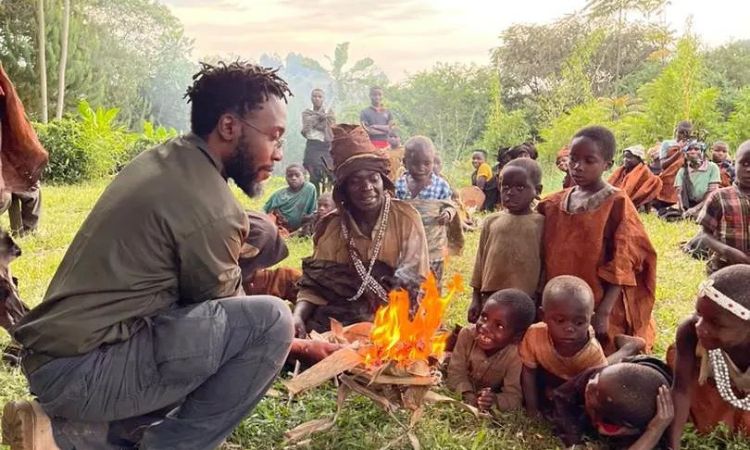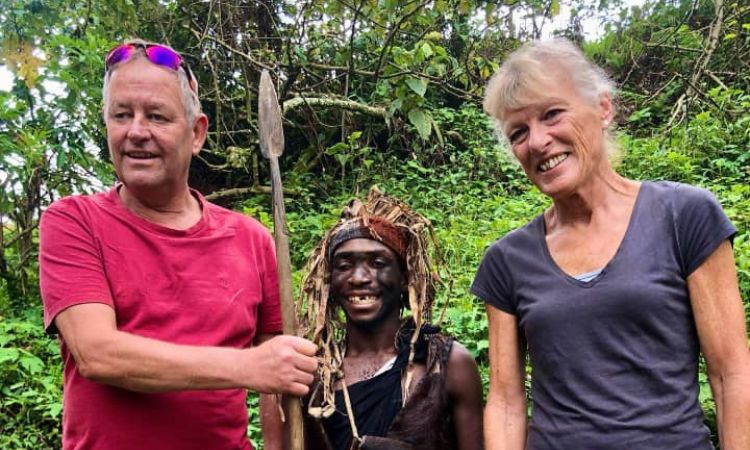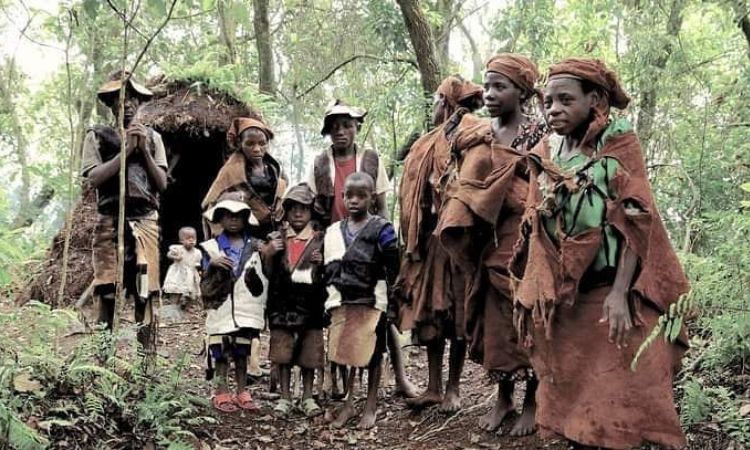Batwa People: History, Height, Language, Food & more
Batwa People: Discover the Batwa People‘s rich history, vibrant culture, ancient traditions, and unique practices in this detailed exploration of their distinct way of life. The Batwa people, also known as the Twa or Pygmies, are an endangered indigenous group in Uganda’s Great Lakes region, revered as the original “Keepers of the Forest.”
For millennia, they thrived as hunter-gatherers in the lush rainforests of Bwindi Impenetrable and Mgahinga Gorilla National Parks, sharing a profound spiritual bond with the land and its wildlife, including the endangered mountain gorillas.
However, in the 1990s, conservation initiatives led to their forced eviction without adequate compensation, displacing thousands and stripping them of their ancestral homes to prioritize gorilla protection.
Today, the Echuya Batwa, named after the sacred Echuya Swamp forests—number fewer than 7,000, facing poverty, discrimination, and cultural erosion. Yet, resilience defines them: through initiatives like the Batwa Cultural Trail, they reclaim their heritage, sharing songs, dances, and foraging wisdom with visitors.
This guide delves into their forest-based livelihoods, oral storytelling, polygamous family structures, and ongoing struggles for land rights. If you’re searching for “Batwa people history and culture,” “Batwa pygmies displacement Uganda,” or “Echuya Batwa traditions and practices,” uncover the heart of their story here.
Who are the Batwa People in Uganda?
The Batwa people are one of the oldest surviving indigenous tribes in kisoro, kanungu, bundibugyo in Africa. They live high in the mountain forests, straddling several east African countries. The Batwa are now called conservation refugees, as governments scramble to cope with the pressures of population growth and climate change.

The Batwa people Uganda are believed to have migrated from the Ituri forest of the democratic republic of Congo in search of wild animals to hunt hence, kisoro literally meaning the area occupied by wild animals. The Batwa live in small huts mainly made from sticks and grass and number 6,700 per a 2014 estimate by the Uganda bureau of statistics.
Average Batwa height
Twa also called Batwa, one of the best-known of the many pygmy groups scattered across equatorial Africa. Like all other African pygmies, the Twa, averaging about 5 feet (1.5m) in height are a people of mixed ancestry, probably descendants of the original inhabitants of the equatorial rainforest.
Batwa Religion
The Batwa people believe in a supreme being locally known as Nagaasan or Imaana. And it is believed that Nagaasan provides the wealth, food, protection and children to the Twa people.
Batwa history and ancestral lands Bwindi Mgahinga
The Batwa people’s history stretches back over 20,000 years, making them one of Africa’s oldest indigenous groups. Anthropological evidence, including rock art and oral traditions, suggests they were the first inhabitants of the Albertine Rift’s montane forests, a biodiversity hotspot spanning Uganda, Rwanda, and the Democratic Republic of Congo.
As pygmy hunter-gatherers—standing between 4 and 5 feet tall on average—they adapted masterfully to the dense, misty rainforests, developing intimate knowledge of flora and fauna that sustained their semi-nomadic lifestyle.
Batwa food included wild honey, fruits, roots, mushrooms, bushmeat, and herbs—supplemented today with maize, beans, cassava, and bananas after resettlement from ancestral forest lands.
In pre-colonial times, the Batwa coexisted symbiotically with Bantu farmers and pastoralists who migrated into the region around the 15th century. The Batwa provided forest products like honey, medicinal plants, and meat in exchange for iron tools and agricultural goods.
This barter system fostered mutual respect, with Batwa often serving as spiritual guides, believed to possess magical connections to the forest spirits. Their oral histories, passed down through generations via epic songs and dances, recount legends of creation where the first Batwa people emerged from the roots of the giant fig trees in Bwindi, embodying the forest’s soul.
The colonial era (1890s–1960s) marked the first major encroachment. British administrators, viewing the forests as untapped resources, introduced logging and hunting regulations that restricted Batwa access to hunting grounds. Yet, it was post-independence conservation policies that delivered the devastating blow.
In 1991, Uganda’s government gazetted Bwindi Impenetrable Forest as a national park to protect the critically endangered mountain gorilla, home to half the world’s population (about 1,063 individuals as of 2025).
Similarly, Mgahinga Gorilla National Park, established in 1991, encompassed sacred Batwa sites like the Gahinga volcano, considered the dwelling place of their ancestral spirits.
The evictions were swift and brutal. Over 800 Batwa families—approximately 4,000 people—were forcibly removed from Bwindi alone, with minimal notice or relocation support. Reports from organizations like Survival International document accounts of violence, including beatings by park rangers and destruction of temporary shelters. The Uganda Wildlife Authority (UWA) justified the actions as necessary for gorilla conservation, which has since boosted ecotourism revenue to over $20 million annually.
However, the Batwa received no compensation, land titles, or alternative livelihoods, leading to a humanitarian crisis. Many resettled on the precarious outskirts of Kisoro and Rubanda districts, surviving on casual labor, begging, or charcoal burning—activities that ironically degrade the very forests they once protected.
This displacement exemplifies “fortress conservation,” a model criticized by scholars like Roderick Neumann in Imposing Wilderness (1998), where indigenous rights are sacrificed for Western environmental ideals.
For queries like “Batwa pygmies displacement Uganda,” this history underscores the irony: the Batwa, who lived sustainably for eons without depleting gorilla habitats, were expelled to “save” the apes they revered as kin.
Why were the Batwa pygmies removed from their forest homes?
In the early 90s, the Uganda government evicted the Batwa people, an indigenous group commonly known as pygmies, from their forest lands. The reason for their displacement was to create national parks aimed at protecting biodiversity and promoting tourism.
The conservation areas that sprang up in this southwestern corner of Uganda are Mgahinga Gorilla National Park, Bwindi Impenetrable National Park, and Echuya forest reservation all are home to endangered mountain gorillas with Bwindi hosting approximately 51% of the global population of this subspecies.
Yet these forests were also the ancestral lands of the Batwa people, who hunted tree species. Today, a large portion of the minority Batwa population lives in Kisoro district, on the border with Rwanda and the democratic republic of Congo.

Since their eviction in the early 1990s, their livelihoods and culture have largely suffered, and many Batwa became squatters living in extreme poverty. The evicted did not receive adequate compensation or resettlement from the government, for which Uganda’s highest court ruled only this year that the government was culpable. \
Some members currently reside on land donated by churches, such as the michinga Batwa settlement camp given by the diocese of muhabura. Other members were resettled by groups such as the gorilla organization (GO) and the United Organization for Batwa Development in Uganda. The latter has created approximately 33 Batwa settlements in kisoro.
Batwa language, crafts and traditional skills
At the core of Batwa identity is their profound cultural heritage, rooted in animism and communalism. Traditional Batwa society is egalitarian, with decisions made in council circles under the guidance of elders. Polygamy is common among men, reflecting the need for large families to support foraging expeditions, though women hold significant influence as primary caregivers and herbalists.
Social bonds are reinforced through rites of passage: boys undergo initiation hunts at age 12, learning to track duikers and set snares, while girls master bark-cloth weaving and plant identification.
Batwa traditions revolve around the forest as a living entity. Their cosmology views the Echuya Swamp—a vast papyrus wetland in southwestern Uganda—as the womb of creation, where spirits like Ruhanga (the supreme being) reside.
Rituals include the Okukaraba ceremony, a trance-inducing dance with drums and flutes to invoke rain or heal the sick. Medicinal practices draw from over 200 plant species; for instance, the bark of the Entandrophragma tree treats malaria, a knowledge system validated by modern ethnobotanists.
Daily practices emphasize sustainability. Hunting with bows and poisoned arrows targets only what is needed, and gathering wild yams, berries, and mushrooms follows seasonal cycles. Batwa dance/music, performed in the Ekuramu style—energetic leaps mimicking forest animals—serve as both entertainment and education, encoding survival lore. Crafts like bow-making from bamboo and beehive construction from vines showcase their ingenuity.
The Batwa language, Rutwa (or Kigezi), is a cornerstone of this heritage. An oral Bantu dialect with clicks and tonal inflections, it encodes forest-specific terms, such as ekirere for a gorilla’s footprint or orugara for a hidden water source.
With only about 6,000 fluent speakers, Rutwa faces extinction, overshadowed by Luganda and Runyankole. Preservation efforts, like those by the Batwa Development Programme, include bilingual storybooks and radio broadcasts. For those querying “Batwa language Rutwa Kigezi,” understanding this linguistic treasure reveals how language preserves ecological wisdom.
Batwa crafts reflect their forest ingenuity: women weave intricate baskets and mats from vines for storage, craft bark-cloth clothing from mutuba trees, and shape pottery for cooking. Men carve wooden tools, bows, arrows, and beehives, using natural dyes for patterns symbolizing wildlife.
Art and spirituality intertwine in Batwa practices. Rock paintings in Echuya depict hunting scenes, while storytelling sessions around campfires recount myths of trickster animals teaching humility. Polygamous households, led by matriarchs skilled in midwifery, foster extended kin networks, ensuring knowledge transfer.
The Echuya Batwa: Guardians of the Swamp
The Echuya Batwa, a subgroup numbering around 3,000, are particularly tied to the Echuya Central Forest Reserve, a 37,000-hectare swamp forest straddling Kabale and Rubanda districts.
Unlike their Bwindi kin, Echuya Batwa maintained semi-permanent settlements around the swamp’s edges, fishing in papyrus channels and harvesting papyrus for mats. Their traditions emphasize water spirits, with annual Kwezi festivals involving boat races and offerings of fish to appease flood deities.
Displacement hit Echuya hard in the 2000s, as the reserve was expanded for biodiversity protection. Today, they navigate urban fringes, where HIV/AIDS rates are double the national average due to poverty-driven vulnerabilities.
Yet, cultural revival thrives: the Echuya Batwa Cultural Centre offers workshops on traditional crafts, drawing tourists for authentic experiences. Queries on “Echuya Batwa traditions and practices” often lead here, highlighting their role in sustainable ecotourism.
How Batwa people adapt after losing forest homes
After their 1990s eviction from Uganda’s Bwindi and Mgahinga forests for gorilla conservation, the Batwa adapted by shifting from hunter-gathering to subsistence farming on rented plots, growing potatoes, fruits, and vegetables.
Many now serve as cultural guides on the Batwa Trail, earning income through ecotourism and sharing traditions like dances and foraging demos. NGOs like UOBDU provide land access, education, and health support, blending ancestral knowledge with regenerative agriculture.
Despite poverty and discrimination, they build semi-permanent homes and advocate for land rights, preserving resilience amid cultural erosion.
Challenges faced by the Batwa community in Uganda
Post-eviction, the Batwa People Uganda endure multifaceted hardships. Economically, over 80% live below the poverty line, relying on UWA’s meager benefit-sharing schemes—less than 1% of park revenues trickles down. Health issues plague them: limited access to clinics results in high infant mortality (150 per 1,000 births), and forest exile exacerbates respiratory diseases from smoky settlements.
Socially, discrimination persists; labeled “backward pygmies,” Batwa face exclusion from schools and jobs. Land rights remain elusive; despite a 2010 court ruling granting symbolic access to Bwindi, implementation lags. Climate change compounds woes, drying swamps and reducing wild foods, forcing reliance on aid from NGOs like COPAP and the Indigenous World Association.
For “Batwa pygmies displacement Uganda,” these struggles spotlight systemic injustices, echoed in UN reports urging reparations.
Revival and Future Prospects
Hope glimmers through advocacy. The Batwa Trail in Mgahinga, launched in 1999, employs 20 Batwa as guides, earning $10–$15 daily while demonstrating foraging. Cultural festivals, like the annual Batwa Day in Kisoro, showcase dances and crafts, generating income. Education initiatives, including scholarships from the Batwa Cultural Trust, boost literacy to 40% among youth.
Internationally, the Batwa’s plight inspires movements; their 2016 petition to the African Commission on Human Rights seeks land restitution. As gorilla tourism booms—Bwindi hosts 20,000 visitors yearly—the Batwa advocate for co-management, blending conservation with rights.
Ancestral Lands: Bwindi and Mgahinga in Focus
Bwindi Impenetrable Forest, a UNESCO World Heritage Site covering 331 square kilometers, was the Batwa’s heartland. Its impenetrable thickets hid sacred groves where they buried ancestors and harvested Rwandan loquat fruits. Mgahinga, at 33 square kilometers, features volcanic craters revered as spirit homes; Batwa lore describes the Sabinyo volcano as a sleeping giant guarding their secrets.
Eviction severed these ties, but spiritual reconnection occurs via guided tours, where Batwa share how they once “talked” to gorillas through mimicry. For “Batwa ancestral lands Bwindi Mgahinga history,” this reveals a lost symbiosis, urging ethical tourism.
Efforts to restore land rights for Batwa people
Efforts to restore land rights for Uganda’s Batwa, displaced from Bwindi, Mgahinga, and Echuya forests in 1991, include legal and community-led initiatives. A 2021 Constitutional Court ruling declared the evictions unconstitutional, sparking hope, but government appeals and slow implementation persist.
The United Organisation for Batwa Development in Uganda (UOBDU) advocates for land restitution, securing small plots through donations and promoting agroecology via programs like BIDO’s Seeds of Sovereignty.
The Batwa Cultural Trail generates income while preserving heritage. NGOs train Batwa as paralegals to fight for legal recognition, though systemic discrimination and lack of compensation remain challenges.

The Batwa cultural experience.
The Batwa culture is such an amazing experience created by the displaced Batwa pygmies to educate their children and also to share their traditional ways to visitors. Visiting a traditional Batwa homestead you can learn how Batwa women prepare food and serve a meal.
You will also have a chance to sample their traditional dishes. Batwa people are good at storytelling, and you will be able to visit the community and hear their traditional songs. You can also be able to see how they lived and hunted in the traditional manners and enjoy their interesting hunting techniques as the Batwa people teaches you how to crack with a bow and arrow.
Things to consider before going for the Batwa cultural trail in Mgahinga.
Level of difficulties. The Batwa trail is a relatively less tremendous activity partly because the trails are well maintained and defined.
There are a few steep areas particularly around the foot of the volcanoes but this should be manageable for anyone with a reasonable level of fitness. Those with heavy luggage or equipment (camera etc.) can hire the services of a local porter at a cost of about 20$.

Cost of the Batwa trail. The experience in Mgahinga costs 80$ for a lone traveler while those travelling in groups pay less. Two international travelers should expect to pay 70$ each while a group of 4 or more will part with 60$. Those interested in capturing the whole experience on camera or producing a documentary will need to pay an additional 400$.
What to wear. While planning to go for the Batwa cultural experience, you also need to take in to consideration what to wear. You should travel with a rain jacket, garden gloves, long sleeve shirts and trousers to help protect you from the rain, thorns and sharp forest tree/plants.
It’s also wise to carry some snacks/packed lunch and bottled water. You might also consider bringing along other essential items like a camera and insect repellents.
Note: unlike gorilla trekking and some of other activities, you don’t need to carry much for the Batwa trail experience. The Batwa experience is usually arranged after gorilla trekking in mgahinga and Bwindi impenetrable national park but the experience can also be under taken after wildlife safari or game drive in Queen Elizabeth national park.
The activity and the experience is comparable to visiting Iby’iwacu cultural village in Rwanda. Both have spice up your east African safari by allowing you take part in and understand the local culture of some Africa’s indigenous tribes while helping support them economically.
Best Batwa Cultural Tours in Uganda
The 5 Days Uganda Gorilla and Cultural Tour is a unique safari experience leading adventurous tourists to the rarely visited Mgahinga National Park within the Virunga Conservation Area in south-western Uganda… View Tour
Our 6 Days Uganda Primates and Cultural Tour Package is about Mountain Gorilla Trekking Uganda, Golden Monkey Trek and Batwa Cultural Experience in Bwindi Impenetrable forest and Mgahinga Gorilla… View Tour
This outstanding and exclusive 15 Days Uganda Rwanda Safari offers visitors a detailed as well as unsurpassed opportunity of enjoying gorilla trekking experiences in Rwanda’s Volcanoes National Park and Uganda… View Tour
Conclusion: Honoring the Keepers
The Batwa’s story is a poignant reminder of the human cost of progress. From ancient forest sages to resilient advocates, they embody unyielding spirit. By supporting cultural initiatives and demanding justice, we can help restore their dignity.
Whether exploring “Batwa people history and culture” or “Echuya Batwa traditions and practices,” let this journey foster empathy and action for these forgotten guardians.